Fire-By-Friction:
Materials of the San Francisco Bay Region
by Dick Baugh
The objective of this report is to list and describe the fire-by-friction
materials that are found near San Francisco Bay, California. This
is to fill a gap which is found in almost all the outdoor survival
and primitive living skills books which I have read. They mention
their favorite fire-by-friction material or materials, none of
which are native to the area where I live. My hope is that
other "fire making enthusiasts" in different parts of the world would also
write similar articles describing the fire-by-friction materials
of their home territory. This article is not intended to be
a reference for plant identification, although several reference
books have relied on my own experiences with using these materials.
The opinions are obviously subjective and reflect my own prejudices
and skill.
MATERIALS THAT WORK:
Selection of suitable materials is a matter of observing nuances.
First, the wood must be dry. Second, just because one piece of
wood from a particular species worked once is no indication that
it will always work. Another parameter to consider is the degree
to which the wood is decayed. Sometimes a small amount of fungal
attack makes subtle changes in the ability to twirl up an ember.
Heartwood very often works better than sapwood. Selection of woods
is very critical. The material must be capable of being ground
into a very fine powder. Any tendency for the powder being ground
off to feel coarse or gritty is a signal that you are wasting
your time and should reject that wood and find something else.
Equally important is the ability of the wood to maintain its structural
integrity at high temperature (up to 800 degrees Fahrenheit) before
the char is ground off. This is discussed in great detail in Bulletin
of Primitive Technology #4.
MATERIALS:
California Incense Cedar
Calocedrus decurrens makes the best hearth boards.
A very soft, light wood which takes very little effort to twirl
up an ember. Use a board or split piece with the annual rings
perpendicular to the surface (quarter sawn). It also smells good.
Incense cedar is native to the Sierra Nevada Mountains and is
only seen in the San Francisco Bay region as a horticultural plant.
It is, however, such a superior wood for hearth boards that it
should be mentioned. The oldest, least dense heartwood is easiest
to ignite with a hand drill.
I have never been successful in creating an ember with an incense
cedar spindle twirled on an incense cedar hearth board. The char
ground off is always coarse and gritty. My only explanation, albeit
not very scientific, is that the wood is so soft that cedar on
cedar wears away so quickly that the ignition temperature is never
reached. I would appreciate comments from anyone who has had experience
with this material.
Elderberry
The common Elderberry of the San Francisco Bay region is Sambucus
mexicana. It is seen along roadsides in the hills. Elderberry
(Sambucus sp.) makes excellent spindles, especially for
a hand spun fire drill. Select shoots that are about 1/2 inch
in diameter and fairly straight. Second or third year growth is
best because the wood will be the correct thickness. Elderberry
spindles work so well because they have a soft pith core of from
3/16 to 3/8 inch diameter. As a consequence when twirling the
drill your muscle power is a rapid rise in temperature. Avoid
first year stems which have too much pith and only a thin wood
section. Cut elderberry shoots while they are green, heat them
in an oven (250 degrees) and straighten them while still damp.
Then leave them in the oven a few hours until they are perfectly
dry. These "non-abo" techniques can only be justified
in that I need to prepare a large number of spindles at a time
for the classes that I help teach. The slower alternative in preparing
spindles is to straighten them with heat while they are green,
tie them in bundles of 2, 3 or 7 and leave them in a warm dry
place. Elderberry wood which is larger in diameter is also good
for hearth boards although fairly dense. As a consequence of its
greater density it requires more "horsepower" from a
hand-spun drill to reach ignition temperature. That is a non-problem
for a bow drill.
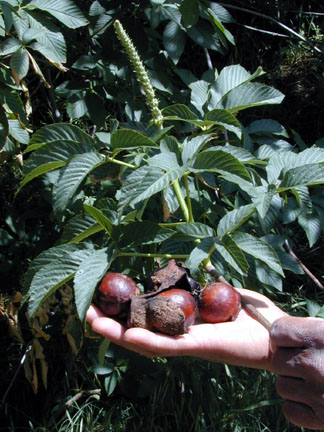 California
Buckeye
California
Buckeye
California Buckeye (Aeschulus californica) works well for
hearth boards and bow drill spindles. I have seldom seen shoots
which were long enough for hand drill spindles. There is a great
variation in its hardness, depending on whether or not it was
cut green or allowed to decay slightly. The less dense wood ignites
more easily.
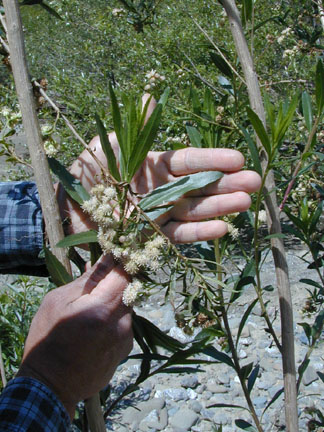 Mule Fat
Mule Fat
Mule Fat (Baccharis viminea) forms long straight stems
in stream beds in California through to Arizona. The soft woody
stems are excellent for spindles and hearth boards. There seems
to be a large variation in the density of the wood, meaning that
some samples require more work than others to twirl up an ember
with a hand drill. The only two times I have ever started a hand
drill fire starting from essentially nothing, have been with mule
fat spindles and hearth boards.
Redwood
Redwood (Sequoia sempervirens). The heartwood works well
for hearth boards. It is a relatively low density wood so little
effort is required but I don't use it very often.
Cattail
Cattail (Typha latifolia) bloom spikes were used in prehistoric
times in Eastern Oregon for hand spun spindles in conjunction
with clematis hearth boards. Jean Auel, author of "Clan of
the Cave Bear," etc. learned her stone age survival skills
from Jim Riggs in Eastern Oregon. Hence Ayla, the heroine of Auel's
books, used cattail bloom spikes plus clematis to start her fires.
I haven't had any success with cattail spindles but I know a lot
of people who have.
Typha leaves are also usable for cordage for making a bow drill.
Cut the leaves at dirt level, ideally while they are still green
and scrape off the slimy stuff that accumulates at the base of
the leaves. Split them into long strips and then let them dry.
Moisten and then twine them into a two-ply cord about as thick
as a pencil. The finer you split the leaves the stronger the cord
will be. This is not very strong cordage but will suffice for
making a few bow drill fires before it breaks.
Mare's Tail
Conyza canadensis, a common weed makes excellent spindles
for hand spun fires. It is a member of the sunflower family (compositae)
frequently found near freeway on ramps. It forms straight, tapered
shoots with relatively soft woody stems which are easy to straighten
with heat. The combination of a mare's tail spindle and an incense
cedar hearth board for me takes the least effort for a hand drill
fire.
Box Elder
Acer negundo is a streamside tree in the maple family.
The wood is white, medium hard and very reliable for bow drill
spindles and hearth boards and spindles.
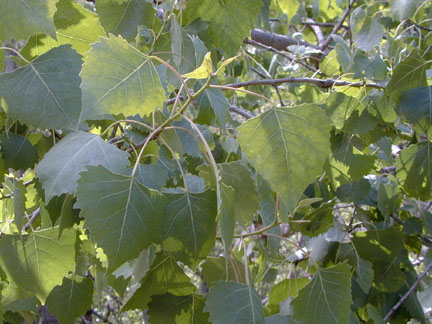 Cottonwood
Cottonwood
Populus sp. are found near water. They are excellent
for spindles and hearth boards.
Willow
Salix sp. are almost always found near a source of
moisture, whether it is a stream or natural seepage. My experience
with willow wood has been a complete failure. It seems to disintegrate
before it reaches ignition temperature but not so fast! Norm Kidder
learned from Pegg Matthewson who read it in a book that local
Indians used cattail stems for spindles and willow root for hearth
boards. Norm tells me that this combination works well. Tree roots
are another source of materials which should not be overlooked.
TINDER MATERIALS:
So, you have twirled up a glowing ember. Now what? Gather some
tinder. Materials which I have successfully used are:
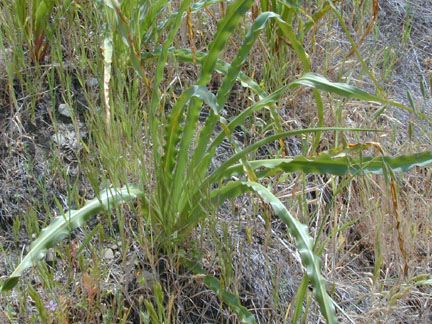 The husk from Soaproot (Chlorogalum
pomeridiadum) is excellent.
The husk from Soaproot (Chlorogalum
pomeridiadum) is excellent.
Dry pounded grass. It's ubiquitous.
Dry shredded Cattail leaves (Typha sp.)
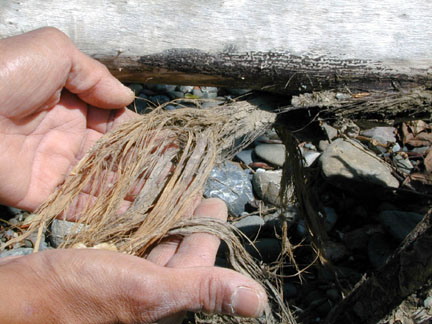 Rotten inner bark
from Cottonwood (Populus sp.)
Rotten inner bark
from Cottonwood (Populus sp.)
Nettle fiber (Urtica sp.)
Milkweed fiber (Asclepias sp.)
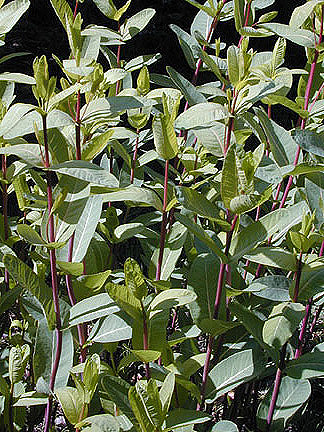 Dogbane fiber (Apocynum cannabinum)
Dogbane fiber (Apocynum cannabinum)
Redwood bark (Sequoia sempervirens)
Powdered gall from oak trees (Quercus sp.) is useful
if you don't have good tinder. It can be sprinkled on a glowing
ember and gently fanned to obtain a very large ember. The shavings
or dry pine needles are also fanned into a fire. Powdered dry
rotten wood can be used the same way as powdered oak gall.
SOCKET MATERIALS:
The socket for a bow drill can be made either from a pitch saturated
knot from a downed rotten Douglas Fir (Pseudotsuga taxifolia)
or very hard wood such as Greasewood (Adenostoma fasciculatum).
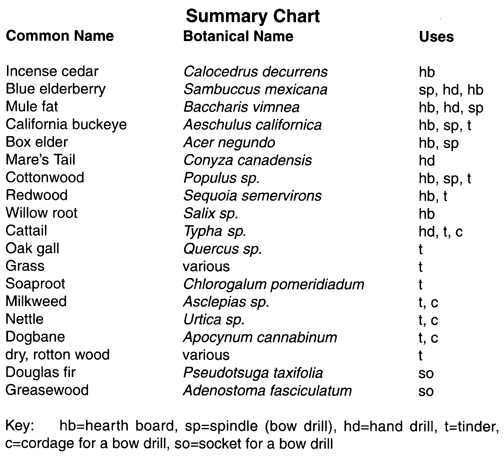

This article was first published in The
Bulletin of Primitive Technology (Fall 1994, #8)
E-mail your comments to "Richard A. Baugh" at richardbaugh@att.net
E-mail questions answered
about fire-by-friction.
PrimitiveWays
Home Page
We hope the information on the PrimitiveWays website is both instructional and enjoyable. Understand that no warranty or guarantee is included. We expect adults to act responsibly and children to be supervised by a responsible adult. If you use the information on this site to create your own projects or if you try techniques described on PrimitiveWays, behave in accordance with applicable laws, and think about the sustainability of natural resources. Using tools or techniques described on PrimitiveWays can be dangerous with exposure to heavy, sharp or pointed objects, fire, stone tools and hazards present in outdoor settings. Without proper care and caution, or if done incorrectly, there is a risk of property damage, personal injury or even death. So, be advised: Anyone using any information provided on the PrimitiveWays website assumes responsibility for using proper care and caution to protect property, the life, health and safety of himself or herself and all others. He or she expressly assumes all risk of harm or damage to all persons or property proximately caused by the use of this information.
© PrimitiveWays 2014
 California
Buckeye
California
Buckeye Mule Fat
Mule Fat Cottonwood
Cottonwood The husk from Soaproot (Chlorogalum
pomeridiadum) is excellent.
The husk from Soaproot (Chlorogalum
pomeridiadum) is excellent.  Rotten inner bark
from Cottonwood (Populus sp.)
Rotten inner bark
from Cottonwood (Populus sp.) Dogbane fiber (Apocynum cannabinum)
Dogbane fiber (Apocynum cannabinum)